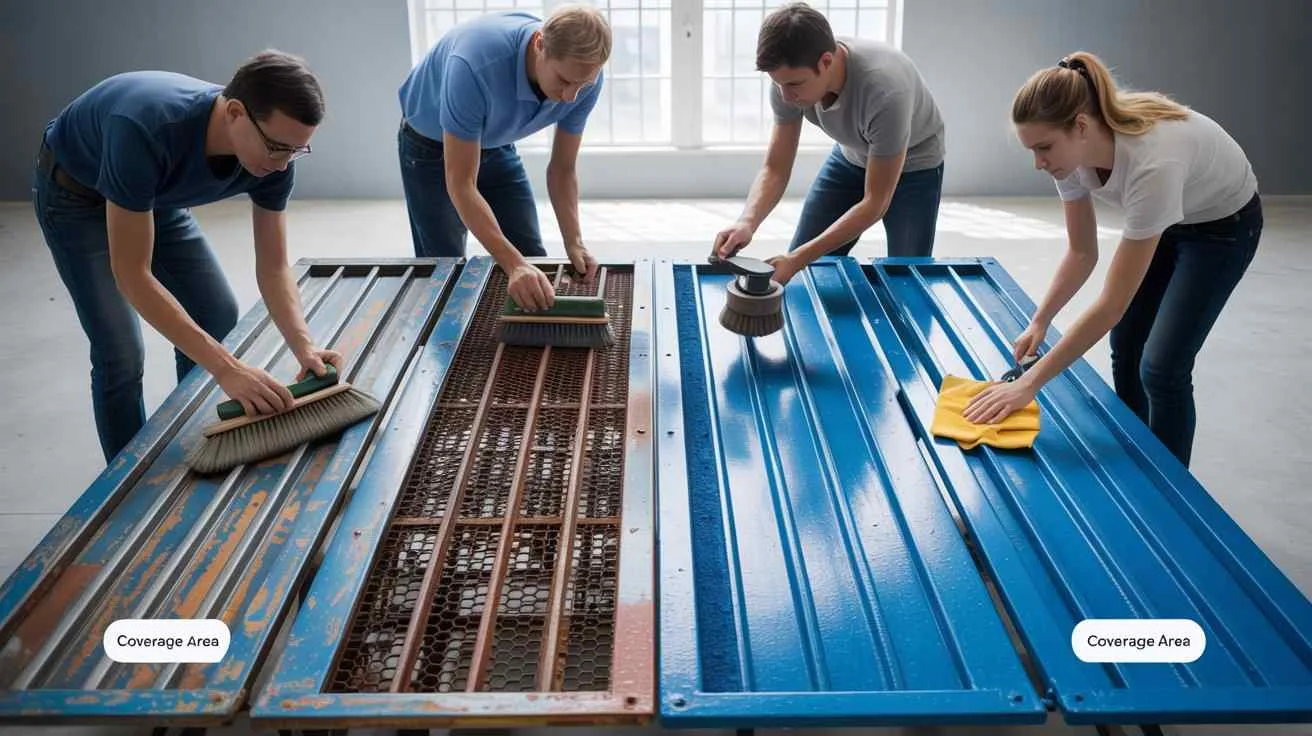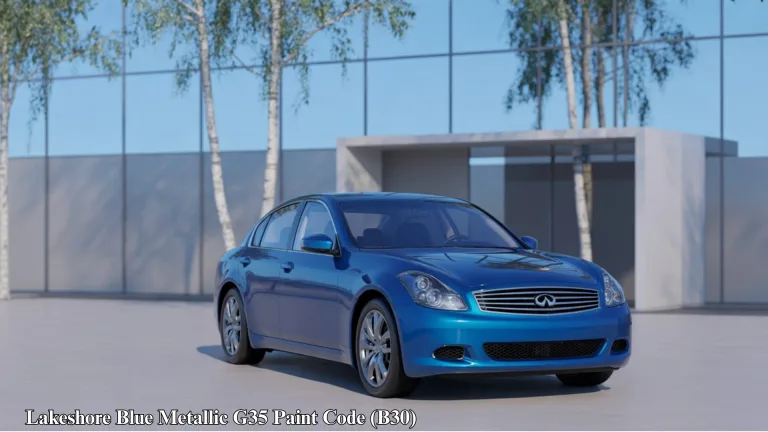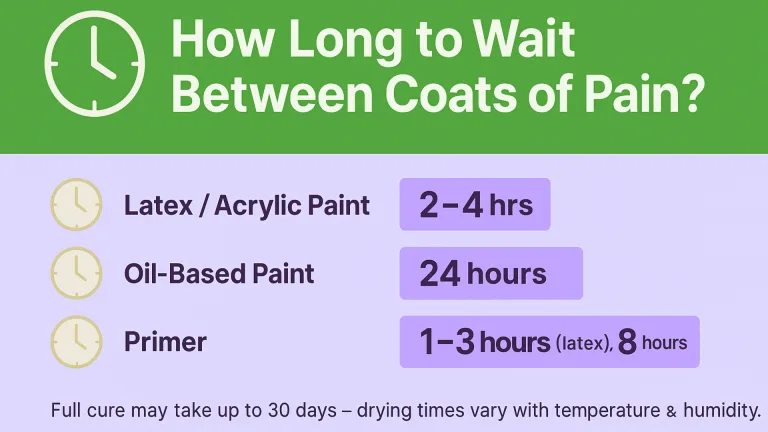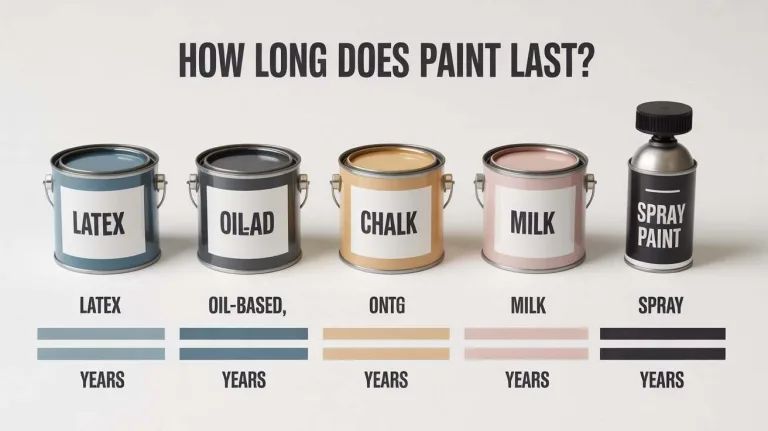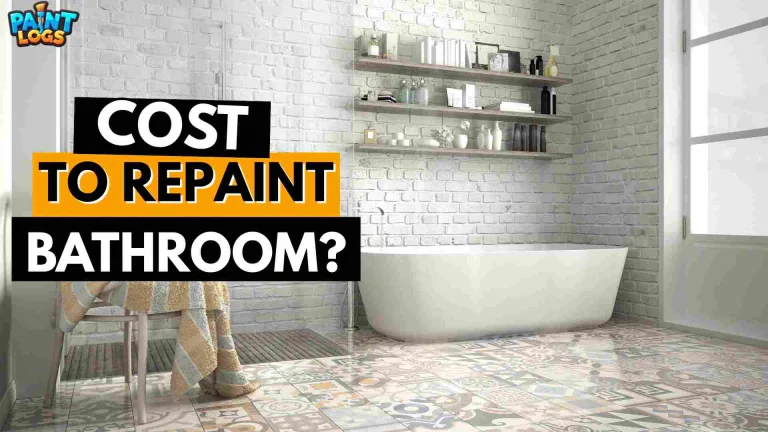If you’re painting, one quart of paint for metal typically covers between 30 and 100 square feet, depending on the surface condition, number of coats, and paint type.
- On smooth, primed metal → expect around 80–100 sq. ft.
- On rough, unprimed, or rusted metal → closer to 30–50 sq. ft.
Now that you have the quick answer, let’s look deeper.
Painting metal isn’t the same as painting drywall or wood. Metal surfaces don’t absorb paint—they rely on proper adhesion, prep, and protection. That means the same quart of paint can behave very differently depending on whether you’re painting a smooth steel door, a rusty gate, or a decorative railing.
This guide covers everything you need to know about using a quart of paint for metal:
how much it really covers, the best paint types to use, real project examples, and how to make your quart go further without sacrificing durability.
Understanding What a Quart of Paint Means
A quart is one-quarter of a gallon, or 32 fluid ounces. Most paint manufacturers list coverage per gallon, usually between 300 and 400 square feet depending on brand and formulation.
On paper, dividing that number by four gives an estimate of 75 to 100 square feet per quart. However, this assumes ideal conditions—flat, smooth, primed surfaces and a single coat. Metal is rarely that forgiving.
Because metal surfaces vary in texture, reflectivity, and composition, real-world coverage from a quart of paint often drops below the manufacturer’s ideal figures.
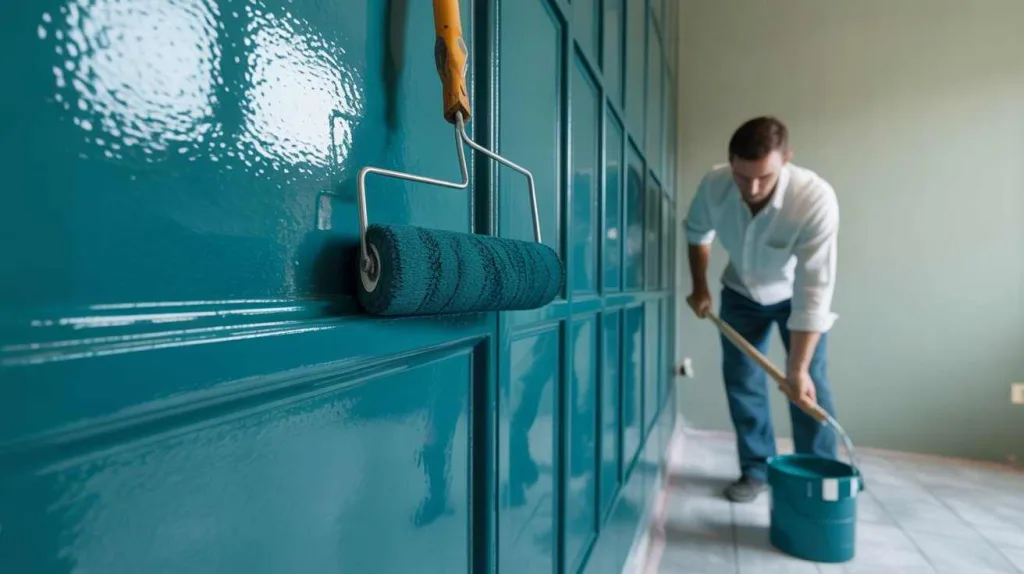
How Much Does a Quart of Paint Cover on Metal?
On average, a quart of paint will cover:
- 80–100 square feet on smooth, primed metal with one coat
- 50–70 square feet on unprimed or lightly textured metal
- 30–50 square feet when applying two coats or working on rusted or rough surfaces
If you’re painting an outdoor metal gate, railing, or large door, expect to use more paint than you would on drywall or wood. The combination of edges, curves, and uneven texture increases consumption.
For comparison, see our general coverage guide:
👉 How Much Does a Quart of Paint Cover?
Why Metal Paint Coverage Differs from Other Surfaces
There are several key reasons why paint coverage drops on metal:
1. Surface Adhesion
Metal doesn’t absorb paint—it relies on mechanical or chemical bonding. If the surface isn’t properly scuffed or primed, paint may bead up or slide, forcing you to apply heavier coats.
2. Surface Texture and Rust
Rust, pitting, and scratches trap extra paint. Even small imperfections can increase paint usage by 10–30%.
Sanding or wire-brushing beforehand helps create a uniform surface that allows thinner, more efficient coats.
3. Priming and Sealing
Bare metal almost always requires a primer. This adds an extra layer of coverage to account for. Even direct-to-metal (DTM) paints benefit from a sealing layer in humid or outdoor conditions.
4. Multiple Coats
Unlike walls, metal often needs two coats of color or a primer + topcoat combination. Every coat doubles your coverage requirements.
If a quart covers 90 sq. ft. in one coat, you may only get 45 sq. ft. with two coats.
5. Paint Type and Composition
Oil-based paints, high-solids industrial coatings, or rust-preventive formulations tend to be thicker. They create better protection but cover less area per ounce.
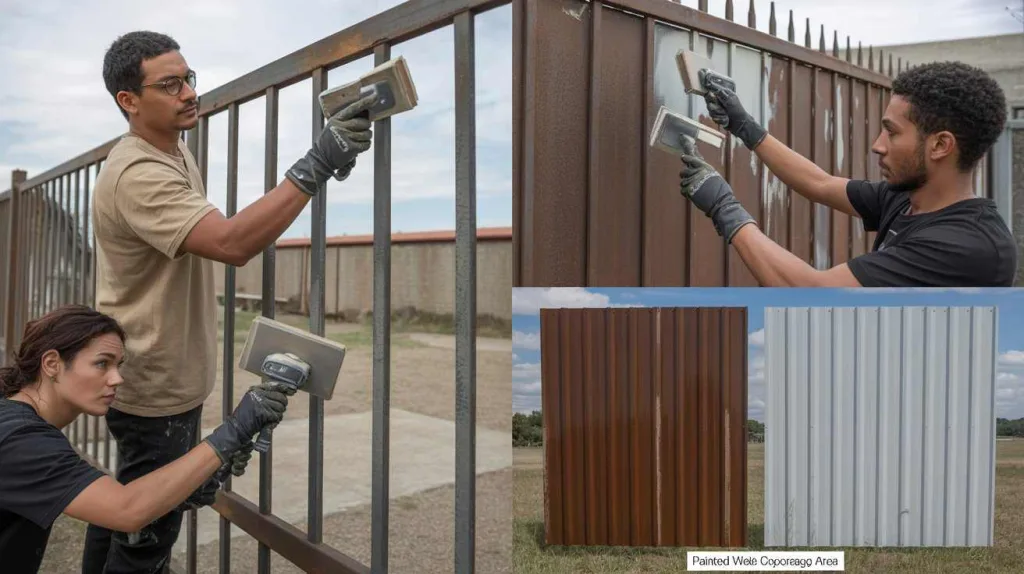
Estimating How Far a Quart Will Go
To estimate how much metal surface one quart can cover, follow this simple method:
- Check the label coverage (per gallon)
Example: 300 sq. ft. per gallon → 75 sq. ft. per quart. - Apply real-world adjustments
- Unprimed or textured metal: multiply by 0.8
- Two coats: divide by 2
- Add a 10–20% buffer for touch-ups
Example 1: Metal Door
A standard metal door is roughly 21 sq. ft. per side (42 sq. ft. total).
- Base coverage: 75 sq. ft.
- Two coats = 37 sq. ft. effective.
Result: One quart should be just enough for both sides with minimal leftover.
Example 2: Metal Railing
A 12-foot railing with posts might have around 70 sq. ft. of total surface area (when accounting for both sides and bars).
- You’ll need 2 quarts for full coverage with two coats.
Example 3: Metal Furniture
A 4-foot metal table might only use ¼ to ½ quart, even with two coats.
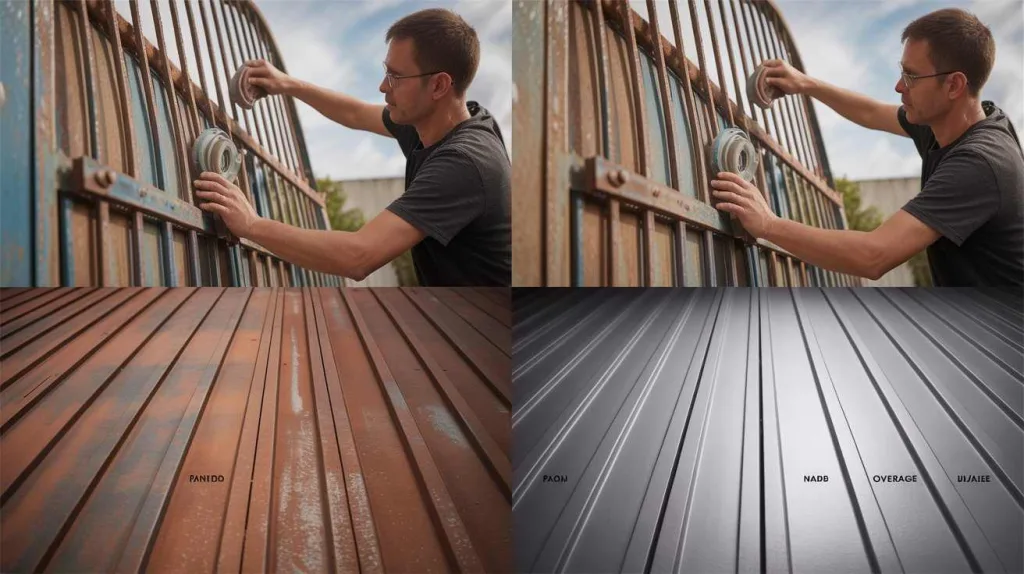
Choosing the Right Type of Paint for Metal
Not all paints are designed for metal. Using the wrong one can cause peeling, bubbling, or poor durability. Below are the main types of paints suitable for metal and how they affect coverage.
1. Direct-to-Metal (DTM) Paints
These are engineered to adhere directly to bare metal without a separate primer. They often provide rust protection and good durability for outdoor use.
- Coverage: 80–100 sq. ft. per quart
- Finish: Usually satin or semi-gloss
- Example: Rust-Oleum Professional DTM Enamel or Behr Premium Direct-to-Metal
Ideal for: gates, doors, industrial metalwork, or exterior surfaces.
2. Oil-Based Enamel Paints
Oil-based paints bond tightly to metal and create a durable, glossy finish that resists moisture and chipping.
- Coverage: 70–90 sq. ft. per quart
- Finish: Gloss or semi-gloss
- Note: Requires mineral spirits for cleanup
Best for: outdoor railings, wrought iron, and machinery.
3. Acrylic and Latex Metal Paints
Water-based metal paints have improved dramatically. They dry faster, emit fewer fumes, and are easier to clean.
Some acrylic enamels are rated for direct-to-metal use but perform best over primer.
- Coverage: 75–95 sq. ft. per quart
- Finish: Matte to satin
Ideal for indoor projects, furniture, or areas not exposed to constant moisture.
4. Rust-Preventive and Specialty Coatings
These contain additives like zinc or rust inhibitors for long-term protection.
- Coverage: 60–80 sq. ft. per quart
- Finish: Satin or protective sheen
- Example: Rust-Oleum Stops Rust Protective Enamel
Best for metal gates, fences, and equipment exposed to weather.
5. High-Performance Coatings (Epoxy or Polyurethane)
For industrial or marine environments, epoxy or polyurethane coatings are unbeatable. However, they’re expensive, dense, and often two-part systems.
- Coverage: 50–70 sq. ft. per quart
- Finish: Extremely durable gloss
- Note: Usually overkill for residential use
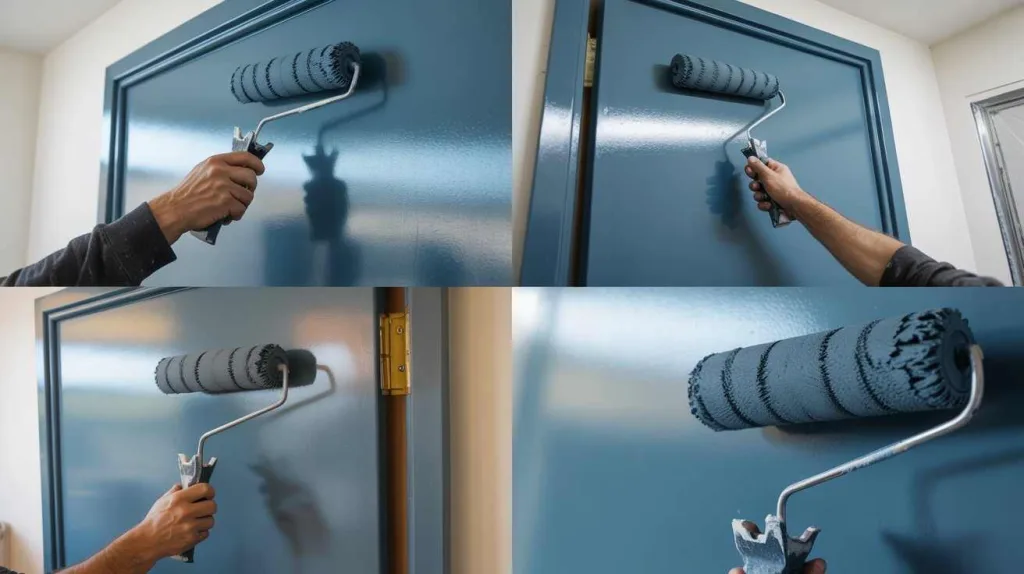
Real-World Coverage Examples
Here are real examples based on actual paint projects and user reports.
| Project | Surface Area | Paint Type | Coats | Quarts Used |
|---|---|---|---|---|
| Metal gate | 40 sq. ft. | Rust-preventive enamel | 2 | 0.75 |
| Garage door | 80 sq. ft. | Acrylic DTM | 2 | 2 |
| Iron railing | 72 sq. ft. | Oil-based enamel | 2 | 2 |
| Metal table | 10 sq. ft. | Acrylic enamel | 2 | 0.3 |
As you can see, coverage varies by prep, texture, and technique. A quart may stretch far on a smooth, primed surface, but you’ll run out quickly on rusted or decorative metalwork.
Common Mistakes That Waste Paint
Even experienced DIY painters make small mistakes that drastically cut coverage. Avoid these common pitfalls:
- Skipping primer or surface cleaning — Oil, dirt, or oxidation prevent adhesion.
- Painting over rust — Rust flakes eat paint and lead to peeling.
- Applying thick coats — More paint doesn’t equal more protection.
- Ignoring drying times — Painting too soon between coats can lift the base layer.
- Using wrong tools — Brushes or rollers not made for metal can soak up too much paint.
- Painting in extreme weather — Heat and humidity cause uneven drying and waste.
How to Make a Quart Go Further
You can easily stretch your paint without compromising quality.
1. Prep Thoroughly
Degrease with mild detergent, sand lightly, and ensure rust is removed or treated with a rust converter.
2. Prime Properly
Even if you’re using a direct-to-metal paint, priming first can reduce paint absorption and improve coverage by up to 20%.
3. Apply Thin, Even Coats
Two thin coats always outperform one thick coat in both coverage and finish.
4. Use Efficient Tools
- Foam rollers for flat metal surfaces
- Quality brushes for detailed edges
- Sprayers for railings or complex shapes (less waste if done correctly)
5. Paint Under the Right Conditions
The ideal temperature range for metal painting is 50°F to 85°F with low humidity. This ensures smooth drying and proper bonding.
6. Save for Touch-Ups
Always keep a small portion sealed for future scratches or rust repair. Metal surfaces tend to chip faster than wood or walls.
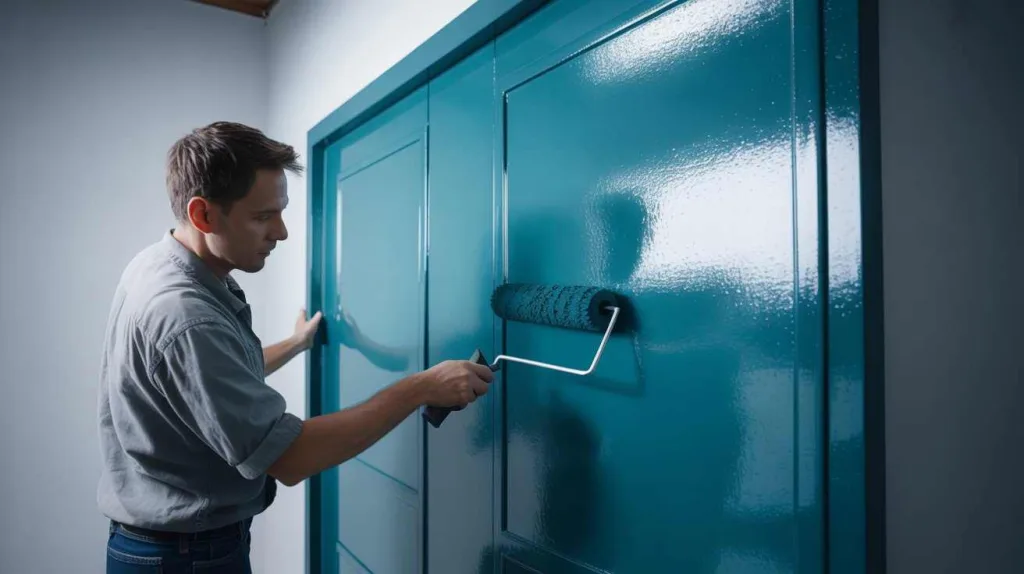
When to Choose More Than a Quart
A quart works great for smaller jobs—like furniture, tools, or trim. But for anything larger, a gallon is more practical and often cheaper per square foot.
You should move up from a quart if:
- The surface area exceeds 40 sq. ft. (for two coats)
- You’re painting multiple items in one color
- You want consistent color tone across large surfaces
- You expect to need touch-ups later
Comparing Quarts to Gallons
| Size | Coverage (1 coat) | Typical Uses |
|---|---|---|
| 1 Quart | 80–100 sq. ft. | Small projects, furniture, doors |
| 1 Gallon | 320–400 sq. ft. | Fences, siding, gates, large equipment |
If you’re unsure, calculate the surface area and always round up. Leftover paint is easier to store than running short mid-project.
Best Practices for Long-Lasting Results
- Clean metal annually to prevent buildup or corrosion.
- Touch up scratches quickly before rust spreads.
- Store leftover paint in airtight containers away from sunlight.
- Use compatible primers and finishes from the same brand for better bonding.
- Lightly sand between coats for smoother texture and stronger adhesion.
Proper preparation and technique can double the lifespan of a metal paint job.
Final Thoughts
A quart of paint for metal can cover anywhere from 30 to 100 square feet, depending on surface type, preparation, and technique. For most small projects—like a door, railing section, or piece of furniture—one quart is ideal.
For larger gates, fences, or multi-coat projects, plan on using more.
By understanding how metal surfaces affect coverage and choosing the right paint type, you’ll avoid running short, save money, and achieve a long-lasting finish.
For more detailed guidance on paint coverage, read our related post:
👉 How Much Does a Quart of Paint Cover?
FAQs: Quart of Paint for Metal
Q: How many square feet will a quart of paint cover on metal?
A: Typically 80–100 sq. ft. on smooth, primed metal, and 30–50 sq. ft. with two coats or on rougher surfaces.
Q: Do I need to use a primer before painting metal?
A: Yes, unless you’re using a direct-to-metal paint. Primers improve bonding and corrosion resistance.
Q: What is the best paint for metal?
A: Oil-based or acrylic direct-to-metal paints such as Rust-Oleum Professional or Behr DTM are reliable for both indoor and outdoor use.
Q: Can I use the same quart of paint for indoor and outdoor metal?
A: Only if it’s labeled for both. Exterior-grade paints have UV and moisture protection that indoor paints lack.
Q: How can I make a quart last longer?
A: Prep well, use thin coats, paint under proper conditions, and seal your paint can tightly for reuse.

